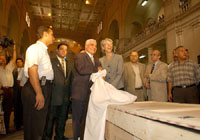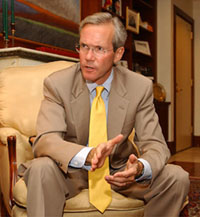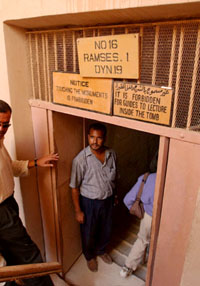 enjoy
telling people the Ramesses story,” says University President
James W. Wagner who, along with other Atlanta and Emory officials
came to Hartsfield-Jackson International Airport to see the
mummy off on October 24. “It typifies Emory, with its unusual
blend of research and ethical discourse. When I tell people
that research helped determine the identity of the mummy as
the grandfather of the Pharaoh in the Bible, they often respond,
‘What a gold mine for Emory.’ But Emory understood
it to be a discovery for the world, which allowed us to do the
right thing and return it to its homeland and people.” enjoy
telling people the Ramesses story,” says University President
James W. Wagner who, along with other Atlanta and Emory officials
came to Hartsfield-Jackson International Airport to see the
mummy off on October 24. “It typifies Emory, with its unusual
blend of research and ethical discourse. When I tell people
that research helped determine the identity of the mummy as
the grandfather of the Pharaoh in the Bible, they often respond,
‘What a gold mine for Emory.’ But Emory understood
it to be a discovery for the world, which allowed us to do the
right thing and return it to its homeland and people.”
As
the Harmony International Youth Chorus sang, Carlos Museum Director
Bonnie Speed signed over the royal mummy to Egyptian authorities.
“This
moment will be engraved in history,” said Hawass. “This
day, when this Pharaoh was returned home to be by his son and
grandson. This is not a small gift from the Carlos Museum, Atlanta,
and the people of America. This is a big gift.”
 Prior
to his journey, the mummy had been carefully packed by conservators
to be able to withstand take-offs and landings. Resting on a
rigid support board, he was surrounded with foam padding to
cradle his head, shoulders, hips, knees, and ankles, and placed
in a nested crate system. Prior
to his journey, the mummy had been carefully packed by conservators
to be able to withstand take-offs and landings. Resting on a
rigid support board, he was surrounded with foam padding to
cradle his head, shoulders, hips, knees, and ankles, and placed
in a nested crate system.
Carlos
curator Betsy Teasley Trope, who accompanied the mummy to Paris
and on to Cairo, was called onto the tarmac at Hartsfield to
oversee the loading of the crate into the cargo hold of a Delta
Air Lines jet. “That’s when I got sort of excited
about the fact that we were returning him, and that this was
a pretty special thing to be involved with,” Trope says.
“The pilot announced on the flight that we were ‘traveling
with royalty,’ and passengers were murmuring about it.
When we got off in Cairo, the press was everywhere, waiting
at the end of the runway, filming the crate as it was unloaded
from the plane.”
Hawass
flew with Trope and the mummy to Cairo and conducted interviews
at the airport with National Geographic, NOVA, CNN, and the
Arab media. Trope then joined Hawass’ staff for the drive
to the Egyptian Museum. “Traffic was crazy. It was close
to gridlock in a few places. The press cars were jockeying for
position. Police were cutting off exits along the route.”
When
they arrived at the museum, Trope saw a banner hanging over
the entrance with Ramesses I’s profile emblazoned over
images from his tomb as well as his cartouche (hieroglyphics
of his name). The true excitement, she realized upon seeing
the elaborate preparations, would be the next day at the press
conference when the crate containing Ramesses I would be opened
for everyone to see.
Joining
Trope in Cairo for the royal mummy’s repatriation ceremony
were the chair of the Carlos Museum board, Charles Ackerman,
and his wife, Joanne; Carlos donor Jim Miller and his daughter,
Lilly; Carlos museum director Speed, director of education Elizabeth
Hornor, and curator Lacovara.
The
American and Egyptian flags were both flying in front of Cairo’s
Egyptian Museum in Tahrir Square as Emory’s delegation
arrived at 9:30 a.m. Sunday. Already, lines of tourists encircled
the famed museum, which houses some 120,000 items in its halls,
including treasures from Tutankhamun’s tomb and a dozen
royal mummies.
Many
of the well-preserved antiquities date back several thousand
years; one of the museum’s oldest artifacts, the famous
slate palette of King Narmer, is five thousand years old. The
cool, quiet Mummy Room was especially fascinating to the Emory
group, who lingered in front of the remains of Seti I and Ramesses
II. Photographs of these mummies in profile hung in the Carlos
Museum gallery as part of the Ramesses I exhibit for months
to demonstrate the uncanny family resemblance.
A
table had been set up near the front entrance for the press
conference, and a crowd of dignitaries, Egyptologists, international
and local reporters and photographers filled the area. Speed
and Lacovara took their seats on either side of Hawass. As a
military band played and children in traditional Egyptian dress
sang, “Welcome Ramesses, the builder of esteemed Egypt,”
the crate containing the royal mummy was brought down a carpeted
path.
“Children
in Atlanta will learn that, once upon a time, there was a king
at the museum there,” Hawass said, as the crowd grew silent.
“And they gave it back to Egypt, without any conditions.
They will learn about love, and peace, and how people should
live together.”
Hawass,
who has for many years lobbied to have important antiquities
returned to Egypt from around the world—especially the
bust of Nefertiti in the Berlin Museum and the Rosetta Stone
in the British Museum—said he hopes the return of the royal
mummy will send a message to other museums to do the same. “These
masterpieces should come to Egypt, home of everyone.”
Speaking
on behalf of the Carlos Museum, Speed said it was “truly
an honor to be here today. We decided the right thing to do
was to return the mummy, which we are 95 percent sure is Ramesses
I. Thank you to all in Atlanta who made the gift of this mummy
possible.”
And
then, with a blare of trumpets and a drum roll, the crowd stood—those
in the back watching large video screens on either side of the
room—and there was a crescendo of clapping and whistling
as the top of the box was removed to give the first glimpse
of the royal mummy.
Museum
officials from both countries looked stricken when a horde of
photographers surged around the crate, holding heavy cameras
directly over the mummy to get the best shot. But Ramesses I
came through unscathed, as he has so many times before.
 That
evening, the Emory delegation was invited to the American Embassy
in Cairo for after-dinner drinks and conversation with Ambassador
David Welch (left). That
evening, the Emory delegation was invited to the American Embassy
in Cairo for after-dinner drinks and conversation with Ambassador
David Welch (left).
“This
is a big deal,” said Welch, in his book-lined office, when
asked about the return of Ramesses I. “This story is wonderful.
It shows a generosity of spirit and a respect for other cultures
that people here assumed was lost. Protecting the history and
culture of this place is profoundly important.”
The
return of Ramesses, unbidden and without expectation, Welch
said, “has probably done more in the past two days for
Egyptian-American relationships than has been done in the past
several years.”
Giving
antiquities back to their homeland is a controversial topic,
and one that is heavily debated in museum circles. Edward H.
Able Jr. ’67C, president and CEO of the American Association
of Museums, based in Washington D.C., says an important factor
in this case is that the artifact is a mummy.
“Human
remains, whether Egyptian or Native American, are a class of
objects all to themselves and have special significance both
in law and in ethics,” he says. “There have been times
when a museum has voluntarily chosen to return other types of
objects to a country of origin, but that is handled on a case-by-case
basis, whereas it is generally accepted in the museum community
today that human remains deserve a more aggressive posture in
repatriation.”
According
to an agreement signed at an international world heritage convention
in 1972, all artifacts illegally taken out of countries after
that date must be returned. “Before that, things were very
iffy,” says Susanne Thomas, associate director of the American
Research Council of Egypt (ARCE), whose U.S. operations are
based at Emory. “Quite a bit was removed in the late 1800s,
pieces that are now in the British Museum, the Metropolitan
Museum of Art, the Boston Museum of Fine Arts, and the Louvre.
Egyptian authorities see the Carlos Museum’s actions as
an example of cooperation in helping to restore the country’s
legacy to its original context.”
The
Carlos Museum’s partnership with Egypt first made international
news in May 2003, when it returned four painted limestone relief
fragments also discovered in the Niagara Falls collection. The
four fragments, recognized by Lacovara as part of Seti I’s
tomb, were replaced as part of that tomb’s restoration.
“That was one of the best moments we have ever had,”
said Hawass. “To put back pieces that had been taken—that
has never happened before.”
These
gifts, Hawass said, have earned the Carlos Museum the opportunity
to do more research in the country, cooperation in developing
new exhibits and, perhaps in the future, a chance to host the
treasures of King Tut when they again tour the United States.
Both
Lacovara and Speed maintain that such favors didn’t factor
into their decision to return Ramesses. “We did this because
it was the right thing to do,” said Speed. “But repatriation
is a very complex issue, and we decide what to do on a case-by-case
basis.”
The
royal mummy, Hawass announced, will be kept in Cairo until it
is moved to its permanent home in Luxor, where it will be the
centerpiece of a Luxor Museum exhibit on Egypt’s military
history.
The
Emory delegation was able to tour the Luxor Museum, as well
as Ramesses I’s tomb, after flying up the Nile to what
was once the thriving city of Thebes, where generations of pharaohs
held court and kings’ statues, temples, and tombs are plentiful.
To
pass through the Theban Hills on the way to the Valley of the
Kings is to go back centuries in time, as donkeys pull carts
along dirt paths and water buffalo graze beside irrigation canals
watering sugar-cane fields. Low, flat houses made of baked mud
bricks line the roadside.
The
red hills are backlit by a cloudless sky so blue and clear that
the contrast is startling, and the whole landscape—which
brings to mind Utah or Arizona in its barren beauty—seems
bleached by the fierce Egyptian sun. The sandy paths to the
tombs are well marked, and bus loads of tourists pull up one
after another.
 As
the Emory group stood in front of Ramesses I’s tomb (left),
there was a palpable anticipation. Lacovara explained that due
to his brief reign, the Pharaoh’s tomb is relatively small
compared to the more elaborate, multi-chambered tombs such as
Seti I’s. To this group, however, Ramesses I’s tomb
is the motherlode, and they descended reverently into his original
burial site. As
the Emory group stood in front of Ramesses I’s tomb (left),
there was a palpable anticipation. Lacovara explained that due
to his brief reign, the Pharaoh’s tomb is relatively small
compared to the more elaborate, multi-chambered tombs such as
Seti I’s. To this group, however, Ramesses I’s tomb
is the motherlode, and they descended reverently into his original
burial site.
“Does
it look familiar?” asked Lacovara, standing in the dim
burial chamber. Many of the wall paintings in the tomb were
reproduced and placed on panels surrounding Ramesses I’s
body while it was displayed at the Carlos Museum. One stunning
section portrays the regal Pharaoh between the gods Anubis and
Hariesis, leading the king into the presence of Osiris, god
of the underworld.
Twenty-five-year-old
Lilly Miller, whose family’s donation in large part made
the purchase of the Niagara collection possible, was awed to
be able to see the royal mummy’s tomb. Struck by the vivid
shades of blue on the walls, she was amazed that such vibrancy
had lasted thousands of years.
“But
seeing the monumental sarcophagus with its beautiful stonework
was what made made me realize the gravity of our trip,”
Miller said later, reflecting on the experience from her home
in Manhattan. “Ramesses I started out from that very spot,
ended up in the Carlos Museum in Atlanta, and now had come full
circle back to Egypt. I really felt honored to be part of an
experience with such a profound purpose, and to be able
to share it with my dad made it even better.”
New
sites are being explored and uncovered by archeologists in Egypt
almost daily, says Shaaban Abd El-Gowad, an Egyptologist who
works with Hawass to preserve the country’s monuments and
artifacts. What has been found, he says, is only a fraction
of the treasures still buried in the sands.
On
their last night in Luxor, El-Gowad and the Emory delegation
gathered in the Howard Carter bar—named for the archeologist
who discovered King Tut’s tomb—at the Old Winter Palace
Hotel. Toasts are made, impressions shared.
No
one has had much rest, but there is a feeling of general contentment
in the room. Across oceans and millennia, a Pharaoh has been
returned. Good nights are exchanged. Softly, someone murmurs,
“Sleep well.”
|